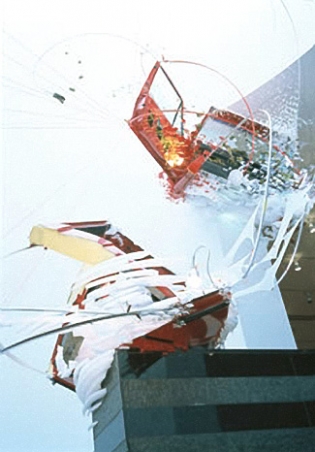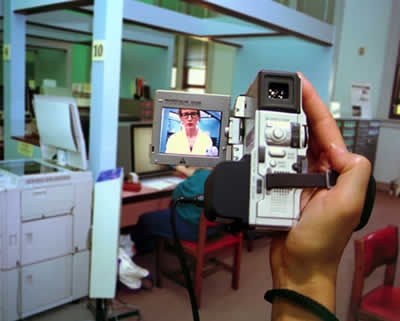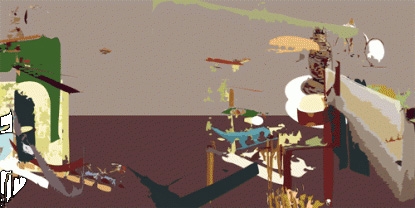
Goo Goo Pow Wow (2000-2001), Chris Finley, Sign enamel on canvas over wood 90 x 180 in. (228.6 x 457.2 cm), Courtesy of ACME, Los Angeles
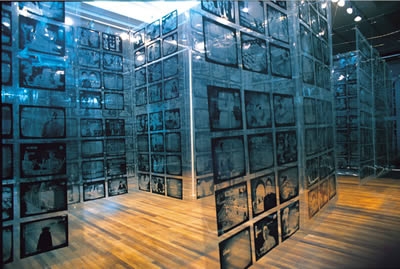
The Fiction between 1999 & 2000 (2000), Hu Jie Ming, Mixed-media installation with sound: transparent film, aluminum frame, nineCD players, nine CDs, and nine speakers, Courtesy of the artist
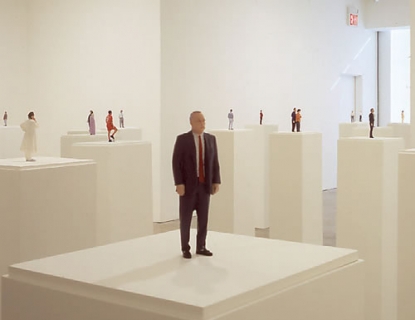
1:10 (1999-2000), Karin Sander, Three-dimensional body scans of the original subjects (fused deposition modeling), rapid prototyping, ABS (acrylonitrile-butadiene-styrene) plastic, and airbrush Each figure exactly 1:10 scale
Feature: Reviews
010101: Art in Technological Times
- San Francisco Museum of Modern Art
- San Francisco
- March 3, 2001 - July 8, 2001
We’re lucky that painting and sculpture have not been entirely displaced by new media. This ensures that in a show like this one we have something to look at while the electronic pieces are being repaired. “Out of Order” is the unintended, uncontrollable leitmotif of technology-oriented exhibitions, and 010101 has featured its share of apologetic notices. But, as the subtitle Art in Technological Times says, this exhibition is about art in our times, not about art that uses technology. It delivers memorable visual experiences in all kinds of ways.
The curatorial team (five curators from different departments produced the exhibition in collaboration) identifies several themes in the exhibition, such as plastic as material and metaphor. Presumably these correspondences originate in widespread cultural trends, as the artists responsible are a diverse group hailing from thirteen countries and working in extremely different media. But there is another simple, yet instructive, way to relate the works to each other. Like Cerberus, the mythical dog with three heads, the works in 010101 view the subject from three different perspectives. There are works that look at technology, works that look at people, using technology, and works that look at people using technology.
It’s All About Tech
Among the works looking at technology are several that make a generally invisible digital reality visible (or audible). This group includes Rebeca Bollinger’s drawings from the Similar/Same series (1999-2000), Annette Begerow’s Constant Memory, Entering the Surface (1999), Droog Design’s Bar Code Reader (2001), Chris Chafe’s and Greg Niemeyer’s Ping (2000-2001) and Hu Jie Ming’s The Fiction between 1999 and 2000 (2000).
Hu Jie Ming’s labyrinth of screen captures translates a cross-section of the Web’s virtual environment into physical space; Bollinger’s drawings depict search results; Begerow’s installation watches a processor at work; Droog’s kinetic sculpture interprets bar codes with moving objects, and the Chafe/Niemeyer piece gives auditory presence to a network tool. Experiencing these works is like meeting someone with whom you’ve had only telephone contact – curiosity is both satisfied and aroused as you explore the gap between your expectations and their presence.
It’s All About Us
At first glance, Jochem Hendrick’s Eye (2001) looks as if it might also be giving visual form to technology. Tangled lines like dissected hairballs cover the pages. But in this instance a machine is making an undetectable human experience – the microscopic movements of a reading eye – visible. Hendricks records the movements with a scanner, then converts them to data that can be output on a computer plotter. The result is as if the reader’s gaze left tracks on the page in the act of reading.
Karin Sander’s 1:10 (1999-2000) also features machine-generated images of human bodies. Sander, who never touches the doll-like figures, orders their construction from the same companies that fabricate models for manufacturers. Their machines scan the subject and copy the results in resin. One doesn’t have to know how the figurines are made, however, to find them compelling. Although 1:10 is billed as a “conceptual” work, the formal qualities – the scale shift and hyper-specific details – are responsible for much of the work’s impact.
Many other works in the exhibition, including Yuan Goang-ming’s Scream, Therefore I Am (1997), Tatsuo Miyajama’s Floating Time (2000), Heike Baranowsky’s AUTO SCOPE (1996-1997) and Jeremy Blake’s Guccinam (2000) and Liquid Villa (2000) explore material familiar from centuries of art. Yuan Goang-ming and Miyajima riff on existential trauma and the passage of time; Baranowsky and Blake animate landscape and abstracted images, respectively. The raison d’etre of their pieces has little to do with technology, although they are executed with the latest techniques. In this context, they remind us that technology may pervade our lives, but our lives are not about technology.
It’s All About Us + Tech
Sarah Sze’s Things Fall Apart (2001) is the most spectacular manifestation of the “people plus technology” theme. Fragments of a red Jeep spill down the central stairway of the museum. Precariously balanced as it looks to be, the red metal still supports strange ecosystems of hypodermic needles, pills, tubing, wire, gauze, and other items. Sze suggests that artificiality has achieved viability. The technological detritus seems to act like crystals that proliferate according to their own laws, coming “alive” with growth and change in a non-human way.
Rodney Grahams’ Edge of a Wood (1999), Lee Bul’s Supernova, and Craig Kalpakjian’s Corridor (1995) are among the other works in this category with elements of threat or alienation. The danger looms or lurks, however, not yet a reality. The atmosphere is one of caution, but not impasse or despair.
It’s Not About…
Despite a few apprehensions about technology, 010101as a whole is not about fear. There are so many imaginative, playful, and yes, sensual, works of art that the cautionary notes balance the mood without souring it. And, 010101 isn’t, by and large, about identity, personality or politics, at least directly. There’s a blessed dearth of postmodernist-style visual quotes from famous art of the past (although there’s an abundance of text-bytes, quotes from various thinkers, flowing on monitors around the galleries.) Could it be that where we’ve been, culturally speaking, is, in technological times, less important than where we’re going?
San Francisco Museum of Modern Art, 151 Third Street (between Mission and Howard),
For more information visit www.sfmoma.org or call 415/357-4000.

